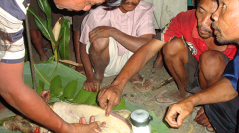

 Anthropozoologica
56 (12) - Pages 181-196
Anthropozoologica
56 (12) - Pages 181-196Drawing on ethnographic data collected since 2012 among three indigenous groups of the Philippines, in Mindoro, Mindanao and Northern Luzon, and on the Field of Anthropological Study (FAS) approach developed by Dutch anthropologists, this paper discusses the role of the pig in three different rituals. The method of killing the animal and the use of their flesh vary in each society. Techniques and specific gestures apply to each ritual. Yet, the three variants share some homologies and variations. The blood of the pig appears as a substance prone to vehiculate qualities, and it is understood first as a recognizable trait for invisibles beings. Cooked or raw, pig blood immunizes against sickness, or conversely brings luck and prosperity. The entrails of the pig, notably the heart, the liver, the spleen and the peritoneum, give signs that cannot be mistaken. The squealing of the pig allows humans to establish a connection with divinities or spirits. The sacrificial dimension of the pig becomes not that relevant compared to its role as a mediator.
Field of anthropological study, ritual, Mangyan.